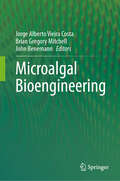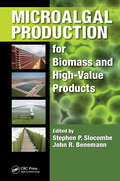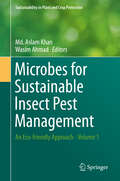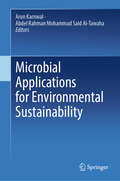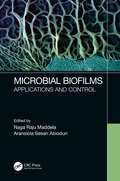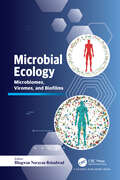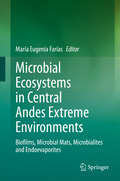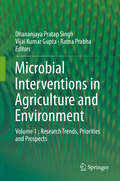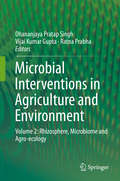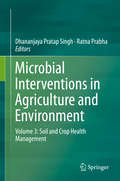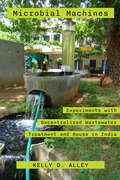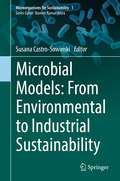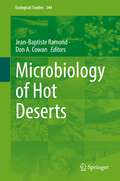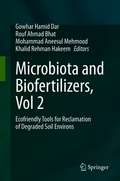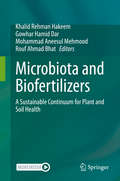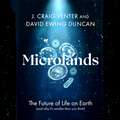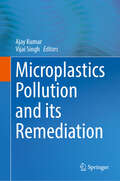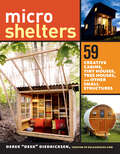- Table View
- List View
Microalgal Bioengineering
by Jorge Alberto Vieira Costa Brian Gregory Mitchell John BenemannThis book presents recent advances, challenges, and trends in modern microalgal biotechnology. It covers microalgae genetics, bioreactors, modeling, massive scale and industrial cultivation, and environmental, social, and economic aspects of microalgal biotechnology. The book also explores the emerging knowledge about high-value bioproducts from microalgae, e.g., biofuels, biosurfactants, bioremediation, bioplastics/biopolymers, pharmaceuticals, antioxidants (anti-aging), fatty acids, polysaccharides and proteins, feed and superfoods with microalgae. The chapters will be written by prominent professors and researchers from the six inhabited continents of the world, from academic to industrial sectors.
Microalgal Production for Biomass and High-Value Products
by Stephen P. Slocombe John R. BenemannMicroalgae are a particularly interesting source of products that range from currently marketed human nutritionals and food ingredients, to potential sources of biofuels and animal feeds. Rapid advances in technology and commercial development are taking place worldwide. Importantly, algal cultivation does not compete with agriculture for land, water, and in some cases, fertilizer resources. Microalgal Production for Biomass and High-Value Products covers the field from a variety of perspectives with 14 chapters contributed by recognized academic experts and industrial practitioners. The book presents the latest technologies and innovations in algal biomass production, from cultivation in open ponds and photobioreactors, to strain selection, synthetic biology, pest control, harvesting, and processing. It explores novel algal products and addresses key issues, including markets, supply chains, business strategies, legal issues, current products, and future prospects. This book brings together the latest advances of interest to those already working in the field while providing an introduction to those beginning to learn about the promise of microalgae as a sustainable source of both specialty and commodity products. It gives stimulating overviews from many different perspectives that describe how laboratory and applied research are creating advances in commercial microalgae production. It also addresses the still many open questions and challenges in this field.
Microbes and Enzymes in Soil Health and Bioremediation (Microorganisms for Sustainability #16)
by Ashok Kumar Swati SharmaMicrobial enzymes play a vital role in maintaining soil health and removing pollutants from contaminated land. Soil microflora is closely associated with maintaining soil fertility, and the use of chemical pesticides, fertilizers and other volatile sprays in agriculture threatens the health ofthe microbial population in the soil. Every single particle of healthy soil contains millions of bacteria, which interact with the nutrients available, sustaining the nutrient cycle and making this microflora an essential component of life on earth. How do microbes help in the nutrient cycle? Either by intracellular digestion of macromolecules and converting these into smaller units in their metabolic pathways, or by secreting enzymes into the extracellular environment to facilitate the conversion of complex macromolecules into micro-molecules that can be easily absorbed by other living species. To meet demands for energy and food for the growing global population, it is important to protect agricultural land from contamination and maintain its productivity. Heavy metal ions from contaminated land canenter crops, fish or aquatic organismsvia contaminated water, and theseare then taken up by the human body, where they can accumulate and alter the normal microflora.The microbiological component of the soil is ahighly complex system and is still not fully understood. How do microbes survive in the changing physicochemical environment of soil?. This book helps readers understand the mechanism, various routes of microbialsoil remediation, the interactionsof different genera, and how microbial enzymes support the sustainable restoration of healthy soil.
Microbes for Sustainable Insect Pest Management: An Eco-friendly Approach - Volume 1 (Sustainability in Plant and Crop Protection)
by Md. Aslam Khan Wasim AhmadThis Volume comprises 14 chapters in an attempt to provide the reader with available information on safe and effective use of entomopathogens. Chapters in this book dealing with soil-borne entomopathogens and their phylogeny also provide a review on most updated information of their isolation and molecular identification. Employing fungal pathogens in biological control programmes plays a key role, and conidial thermotolerance and oxidative stress are examined in separate chapters. Entomopathogenic bacteria are able to kill their hosts quickly. An important contribution concerns informations provided upon bacterial cytotoxic factors on insect haemocytes. Nematodes are biological control agents safe to the environment. The information with respect to their direct and indirect effects on non-target organisms is provided. Viruses as highly specific, virulent candidates for use as biological insecticides are safe to non-target species. A separate chapter on the role of granuloviruses in IPM contributes a wealth of information. Biopesticides in combination with synthetic insecticides are reported as effective, economic, and eco-friendly. Understanding their interactions will certainly promote their uses. Finally, emphasis has been given on reviewing synergistic and antagonistic interactions of microbial and chemical pesticides, in other chapters.
Microbes for Sustainable lnsect Pest Management: Hydrolytic Enzyme & Secondary Metabolite – Volume 2 (Sustainability in Plant and Crop Protection #17)
by Md. Aslam Khan Wasim AhmadThe search for new strategies of pest control with safer molecules is currently of great importance and interest. Microbe-mediated biological crop protection is an attractive and promising technology with no concern for a negative impact on the environment and biodiversity. Microbial hydrolytic enzymes such as proteases, chitinases, lipases, etc. are attractive for this purpose. They present toxic properties and act synergistically to control pest attacks. Also, some metabolites, that microorganisms produce for their survival or defense, can be explored and exploited for plant protection. The focus of this Volume is on the potential of microbial hydrolytic enzymes and their metabolites in agroecosystem functioning. Subsequent chapters review topics such as microbial hydrolytic enzymes as powerful management tools, chitinases in IPM of agro-horticultural crops, metabolites as pesticides and the importance of the metabolites of entomopathogenic fungi, metabolites and virulence factors. Other topicas include: microbial-based nanoparticles, recombinant DNA technologies to improve the efficacy of microbial insecticides, the effects of entomopathogens on insect predators and parasitoids, and the management of major vegetable insect pests. This Volume provides detailed accounts on the safe use of microbial products for sustainable management of insect pests. Its aim is to build solid foundations for the students, teachers, and researchers interested in eco-friendly management of important insect crop pests.
Microbes to the Rescue: Using Bacteria, Algae and Fungi to Clean Up the Planet (Orca Footprints)
by Yolanda RidgeMicrobes are tiny but mighty, and they're everywhere! When left alone, microbes such as bacteria, fungi and algae are experts at adapting, surviving and thriving under extreme and constantly changing conditions. These natural problem solvers can help fight the climate crisis by gobbling up pollutants, breaking down plastic, generating clean energy and capturing carbon. By harnessing the power of microbes, we can create eco-friendly packaging, farm-free food, and even make it easier to live in space! Microbes to the Rescue will introduce young readers to life on a microscopic level and explore how bacteria, fungi and algae play a key role in the connection between all life on Earth. Let’s get microscopic and learn about how microbes can create a cleaner and more sustainable future. The epub edition of this title is fully accessible.
Microbial Applications for Environmental Sustainability
by Arun Karnwal Abdel Rahman Mohammad Said Al-TawahaThis book focuses on the various applications of microorganisms for sustainable environment and the reduction of hazardous pollutants released in various forms, including xenobiotics, e-waste, pesticides, insecticides, plastic, heavy metals, paper waste, medical waste, textile dyes, and their impact on environmental and human health. The book involves a series of research reports that explain the application of microbes used to solve real-life issues raised due to changes happening in environment, including pollution, by covering applications, including the use of bacteria, fungi, microalgae and biofilm in the detection and degradation of crude oil, pesticides, dyes, e-waste, heavy metals and other pollutants. It also focuses on integrative strategies in the application of microbial nanomaterials for remediation of pollutant. This material will help environmental scientists and microbiologists to learn about existing environmental problems and suggest novel ways to control or contain their effects by employing various treatment approaches.
Microbial Biofilms: Applications and Control
by Naga Raju Maddela Aransiola Sesan AbiodunMicrobial biofilms have both positive and negative effects. This book considers new ways of controlling environmental microbial biofilm such as using phages, nanotechnology, and newly discovered microbial enzymes. A team of contributors shares current, relevant and original research to add weight and recognition to the book. Also, each chapter provides enlightening and relevant tabular information, charts, and illustrations. The book is, therefore, informative, precise, useful and easily digested by users.
Microbial Ecology in Sustainable Agroecosystems (Advances in Agroecology)
by David C. Coleman Diana H. Wall Tanya E. CheekeWhile soil ecologists continue to be on the forefront of research on biodiversity and ecosystem function, there are few interdisciplinary studies that incorporate ecological knowledge into sustainable land management practices. Conventional, high fossil-fuel input-based agricultural systems can reduce soil biodiversity, alter soil community structu
Microbial Ecology: Microbiomes, Viromes, and Biofilms
by Bhagwan Narayan RekadwadThis book highlights the hidden world of microbiomes, viromes, and biofilms on and inside humans. Our bodies have microbiomes, which contain various bacterial communities, and viromes, which contain viruses. These invisible residents are vital to health and sickness. Infections often result from microbiome imbalances. Pathogenic bacteria can outcompete beneficial ones, causing gut dysbiosis and disease. Understanding this interaction allows probiotics to restore balance and fight infections. Microbes have a major impact on the gut-brain axis. Gut bacteria affect mood, behavior, and neurodegenerative illnesses by producing neurotransmitters and influencing brain development. The "diabesity" relationship to microbiome changes underscores its relevance in metabolic illnesses like diabetes and NAFLD. The microbiota can also affect cancer progression. Specific bacterial strains may promote tumor growth or prevent metastasis, enabling microbiome-based cancer treatments. Probiotics—live bacteria—have enormous potential. Beneficial strains can improve intestinal balance, fight infections, and treat diabetes and autoimmune conditions.Fecal transplants or co-sleeping may modify microbial ecosystems and health effects. Microbiomes, viromes, and biofilms are complex, requiring advanced tools. The makeup, function, and interactions of these communities can be characterized using next-generation sequencing (NGS). As NGS technology advances, researchers explore this hidden world, offering a future where microbiome manipulation underpins customized therapy and preventive healthcare. This area has great potential for understanding health, improving well-being, and fighting diseases in innovative ways.
Microbial Ecosystems in Central Andes Extreme Environments: Biofilms, Microbial Mats, Microbialites and Endoevaporites
by María Eugenia FaríasThe Central Andean Altiplane represents a unique extreme environment due to its high altitude, closed basins that modulate the salt pans and saline wetlands surrounded by deserts, as well as the considerable influence of volcanic activity. UV radiation, arsenic content, high salinity, alkalinity and low dissolved oxygen levels, together with extreme daily temperature fluctuations and oligotrophic conditions, shape an environment that resembles the early Earth and, even more, extraterrestrial conditions. By developing simple biofilms stratified microbial mats or complex microbialites, extreme microbial ecosystems, colonize and thrived in different environments like salt flats, wetlands, lakes volcano vents, geysers and deserts. This book presents our current understanding of these amazing ecosystems, providing a basis for their protection and sustainable utilization. The main audience for this book included researchers and graduate students as well as professionals working in the government, mining industry and similar activities.
Microbial Interventions in Agriculture and Environment: Volume 1 : Research Trends, Priorities and Prospects
by Vijai Kumar Gupta Dhananjaya Pratap Singh Ratna PrabhaMicrobial communities and their functions play a crucial role in the management of ecological, environmental and agricultural health on the Earth. Microorganisms are the key identified players for plant growth promotion, plant immunization, disease suppression, induced resistance and tolerance against stresses as the indicative parameters of improved crop productivity and sustainable soil health. Beneficial belowground microbial interactions with the rhizosphere help plants mitigate drought and salinity stresses and alleviate water stresses under the unfavorable environmental conditions in the native soils. Microorganisms that are inhabitants of such environmental conditions have potential solutions for them. There are potential microbial communities that can degrade xenobiotic compounds, pesticides and toxic industrial chemicals and help remediate even heavy metals, and thus they find enormous applications in environmental remediation. Microbes have developed intrinsic metabolic capabilities with specific metabolic networks while inhabiting under specific conditions for many generations and, so play a crucial role. The book Microbial Interventions in Agriculture and Environment is an effort to compile and present a great volume of authentic, high-quality, socially-viable, practical and implementable research and technological work on microbial implications. The whole content of the volume covers protocols, methodologies, applications, interactions, role and impact of research and development aspects on microbial interventions and technological outcomes in prospects of agricultural and environmental domain including crop production, plan-soil health management, food & nutrition, nutrient recycling, land reclamation, clean water systems and agro-waste management, biodegradation & bioremediation, biomass to bioenergy, sanitation and rural livelihood security. The covered topics and sub-topics of the microbial domain have high implications for the targeted and wide readership of researchers, students, faculty and scientists working on these areas along with the agri-activists, policymakers, environmentalists, advisors etc. in the Government, industries and non-government level for reference and knowledge generation.
Microbial Interventions in Agriculture and Environment: Volume 2: Rhizosphere, Microbiome and Agro-ecology
by Vijai Kumar Gupta Dhananjaya Pratap Singh Ratna PrabhaMicrobial communities and their functions play a crucial role in the management of ecological, environmental and agricultural health on the Earth. Microorganisms are the key identified players for plant growth promotion, plant immunization, disease suppression, induced resistance and tolerance against stresses as the indicative parameters of improved crop productivity and sustainable soil health. Beneficial belowground microbial interactions with the rhizosphere help plants mitigate drought and salinity stresses and alleviate water stresses under the unfavorable environmental conditions in the native soils. Microorganisms that are inhabitants of such environmental conditions have potential solutions for them. There are potential microbial communities that can degrade xenobiotic compounds, pesticides and toxic industrial chemicals and help remediate even heavy metals, and thus they find enormous applications in environmental remediation. Microbes have developed intrinsic metabolic capabilities with specific metabolic networks while inhabiting under specific conditions for many generations and, so play a crucial role. The book Microbial Interventions in Agriculture and Environment is an effort to compile and present a great volume of authentic, high-quality, socially-viable, practical and implementable research and technological work on microbial implications. The whole content of the volume covers protocols, methodologies, applications, interactions, role and impact of research and development aspects on microbial interventions and technological outcomes in prospects of agricultural and environmental domain including crop production, plan-soil health management, food & nutrition, nutrient recycling, land reclamation, clean water systems and agro-waste management, biodegradation & bioremediation, biomass to bioenergy, sanitation and rural livelihood security. The covered topics and sub-topics of the microbial domain have high implications for the targeted and wide readership of researchers, students, faculty and scientists working on these areas along with the agri-activists, policymakers, environmentalists, advisors etc. in the Government, industries and non-government level for reference and knowledge generation.
Microbial Interventions in Agriculture and Environment: Volume 3: Soil and Crop Health Management
by Dhananjaya Pratap Singh Ratna PrabhaMicrobial communities and their multi-functionalities play a crucial role in the management of soil and plant health, and thus help in managing agro-ecology, the environment and agriculture. Microorganisms are key players in N-fixation, nutrient acquisition, carbon sequestration, plant growth promotion, pathogen suppression, induced systemic resistance and tolerance against stresses, and these parameters are used as indicators of improved crop productivity and sustainable soil health. Beneficial belowground microbial interactions in the rhizosphere help plants combat abiotic challenges in the unfavourable environmental conditions of native soils. These microorganisms and their products offer potential solutions for agriculture in problematic areas since they are able to degrade xenobiotic compounds, pesticides and toxic chemicals and help remediate heavy metals in the rhizosphere and so make deteriorated soils suitable for crop production. This book compiles the latest research on the role of microbes in the rhizosphere and agro-ecology, covering interaction mechanisms, microbe-mediated crop production, plant and soil health management, food and nutrition, nutrient recycling, land reclamation, clean water systems, agro-waste management, biodegradation, bioremediation, biomass and bioenergy, sanitation and rural livelihood security. It is a comprehensive reference resource for agricultural activists, policymakers, environmentalists and advisors working for governments, non-governmental organizations and industries, helping them update their knowledge of this important, but often neglected, research area.
Microbial Machines: Experiments with Decentralized Wastewater Treatment and Reuse in India
by Kelly D. AlleyAround 2004, members of governmental and nongovernmental organizations, science institutes, and private companies throughout India began brainstorming and then experimenting with small-scale treatment systems that could produce usable water from wastewater. Through detailed case studies, Microbial Machines describes how residents, workers, and scientists interact with technology, science, and engineering during the processes of treatment and reuse. Using a human-machine-microbe framework, Kelly Alley explores the ways that people's sensory perceptions of water—including disgust—are dynamic and how people use machines and microbes to digest wastewater. A better understanding of how the human and nonhuman interact in these processes will enable people to generate more effective methods for treating and reusing wastewater. While decentralized wastewater treatment systems may not be a perfect solution, they alleviate resource stress in regions that are particularly hard hit by climate change. These case studies have broad relevance for solving similar problems in many other places around the world.
Microbial Models: From Environmental to Industrial Sustainability
by Susana Castro-SowinskiThis book describes selected microbial genera from the perspective of their environmentally and commercially sustainable use. By focusing on their physiology and metabolism and combining historical information with the latest developments, it presents a multidisciplinary portrait of microbial sustainability. The chapters provide readers descriptions of each genus in the form of microbial models that move us closer to the goal of sustainability; selected chapters also include worldwide market information and lists of corresponding patents.
Microbiology of Hot Deserts (Ecological Studies #244)
by Don A. Cowan Jean-Baptiste RamondThis book covers the wider aspects of the microbiology of hot desert soil ecosystems, compiling disparate information from a range of relevant desert soil microbial fields.The reader learns about microbial ecology of the more dominant and possibly most important desert habitats, detailing the phylogenetic and functional diversity of these different habitats as well as their potential role in desert ecosystem ecology. Particular attention is also given to microbial stress adaptation in hot desert soils. Furthermore, it is the first volume in this particular field to cover modern metagenomics technologies that can be applied to studies of all aspects of desert microbial communities. Additionally, the book explores viruses and viral communities, which are among the least studied (and little understood) components of desert soil microbial communities. Particular attention is also given to the roles of desert microbial communities in biogeochemical cycling of carbon, nitrogen and phosphorus. Through this book the reader discovers how desert microbiology has been at the forefront of Astrobiology and how it may be used conceptually in future terraforming strategies. Desert ecosystems are increasingly coming into focus given the impacts of climate change and desertification trends, making this volume particularly timely. Each of the chapters is authored by leading international researchers and is a must-read for microbial ecologists.
Microbiomes of Soils, Plants and Animals: An Integrated Approach (Ecological Reviews)
by Rachael E. Antwis Xavier A. Harrison Michael J. CoxThrough a long history of co-evolution, multicellular organisms form a complex of host cells plus many associated microorganism species. Consisting of algae, bacteria, archaea, fungi, protists and viruses, and collectively referred to as the microbiome, these microorganisms contribute to a range of important functions in their hosts, from nutrition, to behaviour and disease susceptibility. In this book, a diverse and international group of active researchers outline how multicellular organisms have become reliant on their microbiomes to function, and explore this vital interdependence across the breadth of soil, plant, animal and human hosts. They draw parallels and contrasts across hosts in different environments, and discuss how this invisible microbial ecosystem influences everything from the food we eat, to our health, to the correct functioning of ecosystems we depend on. This insightful read also pertinently encourages students and researchers in microbial ecology, ecology, and microbiology to consider how this interdependence may be key to mitigating environmental changes and developing microbial biotechnology to improve life on Earth.
Microbiota and Biofertilizers, Vol 2: Ecofriendly Tools for Reclamation of Degraded Soil Environs
by Khalid Rehman Hakeem Rouf Ahmad Bhat Mohammad Aneesul Mehmood Gowhar Hamid DarThe dependence of present farming on artificial input of “chemical fertilizers” has caused numerous ecological tribulations associated with global warming and soil contamination. Moreover, there is an essential requirement for realistic agricultural practices on a comprehensive level. Accordingly, biofertilizers including microbes have been recommended as feasible environmentally sound solutions for agricultural practices which not only are natural, and cost-effective but also preserve soil environs and important biota of agricultural land. In addition, it enhances the nutrient quantity of soils organically. Microbial biofertilizers promote plant growth by escalating proficient absorption of nutrients for the plants and by providing an excellent disease-fighting mechanism.Agriculture, the backbone of human sustenance, has been put under tremendous pressure by the ever-increasing human population. Although various modern agro-techniques boosted agricultural production, the excessive use of synthetic fertilizers, pesticides and herbicides have proven extremely detrimental to agriculture as well as to the environment in which it is carried out. Besides this some faulty agricultural practices like monoculture and defective irrigation, further complicate the scenario by eliminating biodiversity, increasing the efflux of nutrients into the water bodies, the formation of algal blooms, eutrophication, damaging the water quality and lowering fish stocks. Biofertilizers are the organic compounds applied to crops for their sustainable growth and the sustainability of the environment as the microbiota associated with biofertilizers interact with the soil, roots and seeds to enhance soil fertility. Application of biofertilizers results in the increased mineral and water uptake, root development, vegetative growth and nitrogen fixation besides liberating growth-promoting substances and minerals that help the maintenance of soil fertility. They further act as antagonists and play a pivotal role in neutralising soil-borne plant pathogens and thus, help in the bio-control of diseases. Application of biofertilizers instead of synthetic fertilizers could be a promising technique to raise agricultural productivity without degrading environmental quality. The present book focuses on the latest research approaches and updates from the microbiota and their applications in the agriculture industry. We believe this book addresses various challenges and shed lights on the possible future of the sustainable agricultural system.
Microbiota and Biofertilizers: A Sustainable Continuum for Plant and Soil Health
by Khalid Rehman Hakeem Rouf Ahmad Bhat Mohammad Aneesul Mehmood Gowhar Hamid DarAn increasing population has put tremendous pressure on agricultural productivity to fulfill the demands of human consumption. Numerous agricultural activities and techniques have been developed to raise annual crop production globally. While agriculture has succeeded in enhancing the yearly crop productivity, this achievement is at the cost of environmental degradation by applying synthetic persistent substances, such as industrial fertilizers, pesticides, herbicides, etc. Chemical fertilizers are nearly as destructive as they are productive, causing monocultures and consequences associated with elimination of diversity, nutrient pollution as evidenced by algae blooms, eutrophication, water quality issues, lower oxygen levels and dangers to fish stocks. Therefore, the scientific approach to maintain sustainable fertility in soil and plants is to switch over to biofertilisers.Biofertilisers are compounds of organic matter that are applied to crops for growth and health. Their constituent micro-organisms interact in an ecofriendly manner with the soil, root and seeds of plants, promoting the growth of micro-flora that enhances soil fertility. They are known to play a number of vital roles in soil fertility, crop productivity and production in agriculture. Application of biofertilisers results in increased mineral and water uptake, root development, vegetative growth and nitrogen fixation. They liberate growth promoting substances and vitamins and help to maintain soil fertility. They act as antagonists and play a pivotal role in neutralising the soil borne plant pathogens, thereby assisting in the bio-control of diseases. Application of biofertilisers in lieu of synthetic fertilizers could be the promising technique to raise agricultural productivity without degrading the environmental quality. The present book focuses on the latest research approaches and updates from the microbiota ecosystem and their applications in agriculture industry. It also highlights the great potential and possible future of action of microbiota in the development of sustainable agricultural systems.
Microlands: The Future of Life on Earth (and Why It’s Smaller Than You Think)
by David Ewing Duncan J. Craig Venter'An epic travelogue, brimming with the excitement of discovery. With characteristic panache, Venter unveils the teeming array of bacteria, viruses, and eukaryotes that crowd our planet's oceans' - Siddhartha Mukherjee'This page-turner gives . . . the thrill of seeing our planet's largest universe through the brilliant, intrepid eyes of the scientist who has done more than anyone to unlock the secrets of life' - Martine Rothblatt'A tour de force . . . Venter has expanded biology's horizons. This book explores microbial life on a global scale, providing cutting-edge solutions to problems of environmental change' - Aristides Patrinos'A ripping tale . . . to revolutionize our understanding of our bodies, the oceans, and the planet' - Jack Gilbert'An exhilarating account of how creative science is accomplished' - Sir Richard J. Roberts'[A] fascinating tour of Planet Microbe' - Bill McKibben'Venter and Duncan expand our scope of what it means to be alive' - Jamie Metzl'Inspiring ... change[s] our ideas of how biology is done' - TelegraphUpon completing his historic work on the Human Genome Project in 2002, J. Craig Venter declared that he would sequence the genetic code of all life on earth. Thus began a fifteen-year quest to collect DNA from the world's oldest and most abundant form of life: microbes. Boarding the Sorcerer II, a 100-foot sailboat turned research vessel, Venter travelled over 65,000 miles around the globe to sample ocean water and the microscopic life within.In this book, Venter and science writer David Ewing Duncan tell the remarkable story of these expeditions and of the momentous discoveries that ensued-of plant-like bacteria that get their energy from the sun, proteins that metabolize vast amounts of hydrogen, and microbes whose genes shield them from ultraviolet light. The result was a massive library of millions of unknown genes, thousands of unseen protein families, and new lineages of bacteria that revealed the unimaginable complexity of life on earth. Yet despite this exquisite diversity, Venter encountered sobering reminders of how human activity is disturbing the delicate microbial ecosystem that nurtures life on earth. In the face of unprecedented climate change, Venter and Duncan show how we can harness the microbial genome to develop alternative sources of energy, food, and medicine that might ultimately avert our destruction.A captivating story of exploration and discovery, this book restores microbes to their rightful place as crucial partners in our evolutionary past and guides to our future.
Microlands: The Future of Life on Earth (and Why It’s Smaller Than You Think)
by David Ewing Duncan J. Craig Venter'An epic travelogue, brimming with the excitement of discovery. With characteristic panache, Venter unveils the teeming array of bacteria, viruses, and eukaryotes that crowd our planet's oceans' - Siddhartha Mukherjee'This page-turner gives . . . the thrill of seeing our planet's largest universe through the brilliant, intrepid eyes of the scientist who has done more than anyone to unlock the secrets of life' - Martine Rothblatt'A tour de force . . . Venter has expanded biology's horizons. This book explores microbial life on a global scale, providing cutting-edge solutions to problems of environmental change' - Aristides Patrinos'A ripping tale . . . to revolutionize our understanding of our bodies, the oceans, and the planet' - Jack Gilbert'An exhilarating account of how creative science is accomplished' - Sir Richard J. Roberts'[A] fascinating tour of Planet Microbe' - Bill McKibben'Venter and Duncan expand our scope of what it means to be alive' - Jamie Metzl'Inspiring ... change[s] our ideas of how biology is done' - TelegraphUpon completing his historic work on the Human Genome Project in 2002, J. Craig Venter declared that he would sequence the genetic code of all life on earth. Thus began a fifteen-year quest to collect DNA from the world's oldest and most abundant form of life: microbes. Boarding the Sorcerer II, a 100-foot sailboat turned research vessel, Venter travelled over 65,000 miles around the globe to sample ocean water and the microscopic life within.In this book, Venter and science writer David Ewing Duncan tell the remarkable story of these expeditions and of the momentous discoveries that ensued-of plant-like bacteria that get their energy from the sun, proteins that metabolize vast amounts of hydrogen, and microbes whose genes shield them from ultraviolet light. The result was a massive library of millions of unknown genes, thousands of unseen protein families, and new lineages of bacteria that revealed the unimaginable complexity of life on earth. Yet despite this exquisite diversity, Venter encountered sobering reminders of how human activity is disturbing the delicate microbial ecosystem that nurtures life on earth. In the face of unprecedented climate change, Venter and Duncan show how we can harness the microbial genome to develop alternative sources of energy, food, and medicine that might ultimately avert our destruction.A captivating story of exploration and discovery, this book restores microbes to their rightful place as crucial partners in our evolutionary past and guides to our future.
Microorganisms in Home and Indoor Work Environments: Diversity, Health Impacts, Investigation and Control, Second Edition
by J. David Miller Robert A. Samson Brian FlanniganIn 2007, scientists estimated the direct cost of diseases associated with mould and dampness on the US population to be in the range of 4 billion dollars, and the indirect costs of lost work and school days are gauged even higher. The US Centers for Disease Control recently concluded that elimination of moisture and mouldy materials in the home def
Microplastics Pollution and its Remediation
by Ajay Kumar Vijai SinghThe book elaborates on microplastics as a global concern, prompting the need for comprehensive understanding and effective management. It thoroughly explores the various aspects of microplastics, addressing their detection, separation, and contamination in diverse ecosystems. The introductory chapter highlights the global risks associated with microplastics while presenting the challenges and opportunities in tackling this issue. It focuses on the detection techniques employed to identify microplastics, providing insights into the analytical methods and technologies utilized in their characterization. It delves into the separation techniques used to extract microplastics from complex environmental matrices, aiding in their accurate quantification and analysis. The subsequent chapters examine the presence and impact of microplastics in specific ecosystems, including aquatic and terrestrial. It investigates the prevalence of microplastics in water bodies and their detrimental effects on aquatic organisms and elucidates their distribution, transport, and ecological implications on land-dwelling organisms. The book further explores microplastics' occurrence in foods, cosmetics, and air pollution and associated health hazards. It delves into the lesser-known aspects of microplastics influence on nitrogen cycling and nitrous oxide emissions, offering valuable insights into their impact on biogeochemical processes. It discusses microplastics environmental risks and hazards, covering the ecological, biodiversity, and ecosystem-level impacts caused by these persistent pollutants. The concluding chapters focus on sustainable management strategies for mitigating and controlling microplastics proliferation and associated risks. This book provides a comprehensive and multidisciplinary approach for understanding and addressing the challenges posed by microplastics. It serves as a valuable resource for researchers, policymakers, environmentalists, and anyone concerned about the impact of microplastics on planet. This book aims to foster sustainable management practices and contribute to a cleaner and healthier environment by unraveling microplastics complexities.
Microshelters: 59 Creative Cabins, Tiny Houses, Tree Houses, and Other Small Structures
by Derek “Deek” DiedricksenIf you dream of living in a tiny house, or creating a getaway in the backwoods or your backyard, you’ll love this gorgeous collection of creative and inspiring ideas for tiny houses, cabins, forts, studios, and other microshelters. Created by a wide array of builders and designers around the United States and beyond, these 59 unique and innovative structures show you the limits of what is possible. Each is displayed in full-color photographs accompanied by commentary by the author. In addition, Diedricksen includes six sets of building plans by leading designers to help you get started on a microshelter of your own. You’ll also find guidelines on building with recycled and salvaged materials, plus techniques for making your small space comfortable and easy to inhabit.
